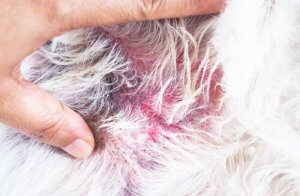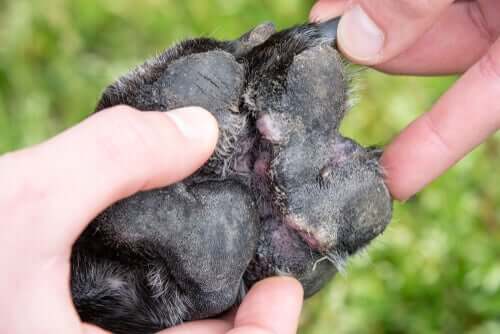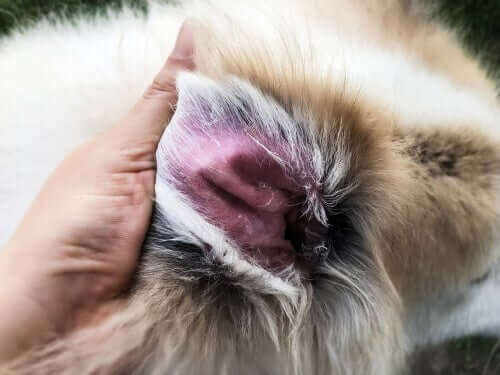Canine Atopic Dermatitis or Eczema

Canine atopic dermatitis, or eczema, is a skin disease that involves swelling and irritation, usually caused by some allergen. In addition, it’s a multifactorial pathology and there’s currently no pharmacological cure.
These days, canine atopic dermatitis is the main skin problem that dogs visit the veterinary clinics for. However, even the causes of this disease are not yet well defined. In addition, it seems that the condition develops differently for every animal.
How do dogs get atopic dermatitis?
Canine eczema appears to be caused by internal factors, or intrinsic to the animal itself, as well as by external or extrinsic factors. Therefore, the sum of these variants and the different pressure that each of the factors can exert will cause the disease to manifest to a greater or lesser degree in the animal.
Up next, we’ll cover the intrinsic and extrinsic factors that can cause this condition in dogs:
Intrinsic factors
The breed plays a fundamental role in the development of canine atopic dermatitis. For example, beagles are known to have a recessive allele for a gene that results in the overproduction of antibodies or immunoglobulin E.
Immunoglobulin E is a protein belonging to the immune system that has a key role in the management of allergens. As a result, this antibody increases the immune response to allergens and triggers an allergic reaction. In addition, there are some cell types that are involved in this reaction:
- Langerhans cells and dendritic skin cells. They are responsible for capturing the allergen.
- Mast cells. They help regulate and lower inflammation.
- B cells. These cells create antibodies.
- Cooperating cells (T cells). They produce substances that activate B cells.
In addition, a set of substances related to inflammatory processes in the development of eczema also play an important role:
- Histamine
- Serotonin
- Leukotrienes
- Cytokines
We should also note that it seems that in both canine and human atopic dermatitis there’s an alteration of the skin’s lipid barrier.
Extrinsic factors
Environmental allergens seem to be the most responsible factors in canine eczema. Moreover, some of these allergens are listed below:
- Pollen from various plants
- Dust mites
- Fungi
- Mold
- Synthetic fabrics
- Insects
Scientists and researchers have found that dust mites are the allergens that cause most eczema, both in the United States and Europe.
On the other hand, it appears that dogs with atopic dermatitis are more likely to suffer from allergic dermatitis caused by flea bites. In addition, dogs suffering from the disease often suffer from secondary infections from staph and Malassezia.

Canine eczema and its symptoms
To determine whether or not a dog is suffering from this pathology, many symptoms should be present simultaneously, in addition to other important criteria.
Because of the many possible causes for these symptoms, veterinarian doctors will commonly begin by asking you questions about your dog’s skin health and itch-related behavior, as well as performing a clinical examination.
Possible symptoms of canine atopic dermatitis are diverse and varied:
- Itching or “pruritus”
- Affected face or fingers
- Thickening of the skin on the inside or outside of the legs
- Episodes of recurrent or chronic dermatitis
- Elevated IgG levels
- High IgE levels
- Malassezia infection
- External otitis in both ears on a regular basis
- Conjunctivitis
- Redness in the skin or face
- Dry skin
Often, the location of the signs (itching, rubbing, redness) is a very useful pointer for identifying the correct disease and thus treating it properly.
When an allergic skin problem has been identified, further tests are available to identify the exact cause.

Nevertheless, there are specific tests (albeit somewhat costly) that can determine what your dog is allergic to. In this way, you can avoid exposing your dog to the allergen as much as possible and thus prevent the negative reaction.
On the other hand, with the help of a veterinarian, you can rule out which substances can harm your dog and completely remove them from their routine. This process takes longer and is more complicated. In addition, you can always start by changing the dog’s diet and incorporating the use of hypoallergenic food.
However, it’s also important to remember that dogs can also develop ‘psychogenic dermatoses’. This condition is an onset of clinical signs that are connected to a stressful event/situation. As a result, the scratching, licking and chewing are emotionally based as opposed to allergenic, and behavioral solutions should be sought.
In sum
This is why our dear pet’s mental well-being is just as important as their physical well-being. Finally, we hope this article will help you in identifying anything in your pet that needs your immediate attention.
All cited sources were thoroughly reviewed by our team to ensure their quality, reliability, currency, and validity. The bibliography of this article was considered reliable and of academic or scientific accuracy.
- Carlotti, D. N. (2011). Dermatitis atópica canina; nuevos conceptos (etiología, patogenia, cuadro clínico, diagnóstico y tratamiento).
- González Zetina, M. D. L. Á. (2019). Alérgenos aerotransportados y alimenticios en perros con diagnóstico de dermatitis atópica (Doctoral dissertation, Universidad de San Carlos de Guatemala).
- LA CATELICIDINA, U. P. A. (2013). Dermatitis Atópica. Nutrición, 5, 31.
This text is provided for informational purposes only and does not replace consultation with a professional. If in doubt, consult your specialist.